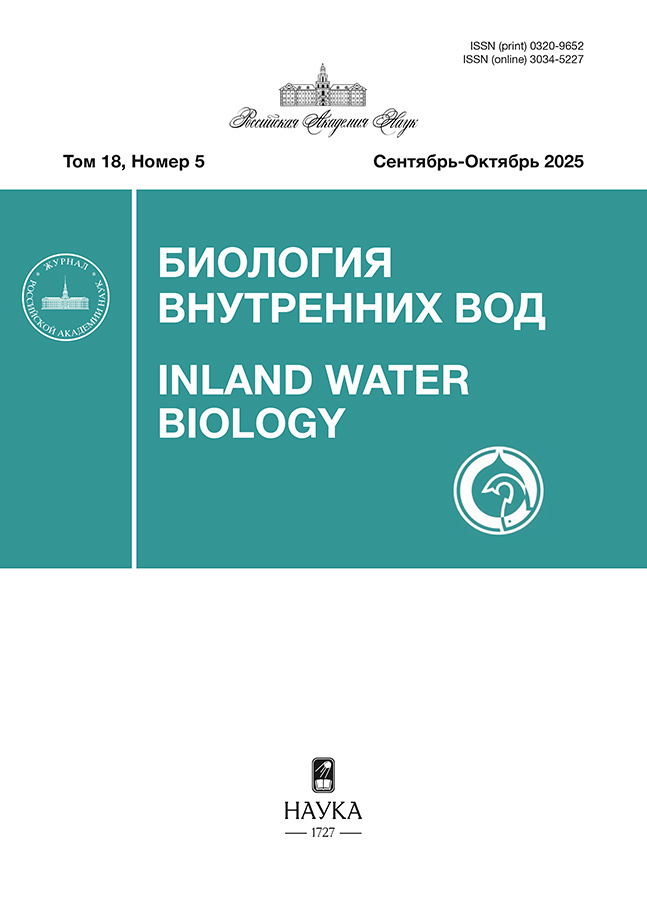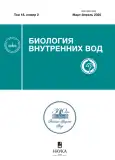Новые молекулярные и фенотипические данные для вида Encyonema simile (Bacillariophyceae)
- Авторы: Багмет В.Б.1, Никулин В.Ю.1, Никулин А.Ю.1, Абдуллин Ш.Р.1
-
Учреждения:
- Федеральный научный центр биоразнообразия наземной биоты Восточной Азии
- Выпуск: Том 18, № 2 (2025)
- Страницы: 260-268
- Раздел: БИОЛОГИЯ, МОРФОЛОГИЯ И СИСТЕМАТИКА ГИДРОБИОНТОВ
- URL: https://bakhtiniada.ru/0320-9652/article/view/306820
- DOI: https://doi.org/10.31857/S0320965225020026
- EDN: https://elibrary.ru/avtbvl
- ID: 306820
Цитировать
Аннотация
Ключевые слова
Об авторах
В. Б. Багмет
Федеральный научный центр биоразнообразия наземной биоты Восточной Азии
Email: chara1989@yandex.ru
Владивосток, Россия
В. Ю. Никулин
Федеральный научный центр биоразнообразия наземной биоты Восточной АзииВладивосток, Россия
А. Ю. Никулин
Федеральный научный центр биоразнообразия наземной биоты Восточной АзииВладивосток, Россия
Ш. Р. Абдуллин
Федеральный научный центр биоразнообразия наземной биоты Восточной АзииВладивосток, Россия
Список литературы
- Багмет В.Б., Казарин В.М. 2021. Предварительные данные по флоре Bacillariophyta в почвах Cмирныховского района (остров Cахалин, Россия) // Комаровские чтения. № 69. С. 130. https://doi.org/10.25221/kl.69.9
- Багмет В.Б., Абдуллин Ш.P. 2023. Находки новых Bacillariophyta для России и острова Cахалин // Turczaninowia. T. 26. № 3. C. 108. https://doi.org/10.14258/turczaninowia.26.3.8
- Давидович Н.А., Давидович О.И. 2022. Репродуктивная биология диатомовых водорослей. Симферополь: ИТ “АРИАЛ”.
- Кузяхметов Г.Г., Дубовик И.Е. 2001. Методы изучения почвенных водорослей. Уфа: РИО БашГУ.
- Куликовский М.С., Глущенко А.М., Генкал С.И., Кузнецова И.В. 2016. Определитель диатомовых водорослей России. Ярославль: Филигрань.
- Медведева Л.А., Никулина Т.В. 2014. Каталог пресноводных водорослей Юга Дальнего Востока России. Владивосток: Дальнаука.
- Рощин А. М. 1994. Жизненные циклы диатомовых водорослей. Киев: Наук. думка.
- Хедаириа Т., Охапкин А.Г., Генкал С.И., Глущенко А.М., Куликовский М.С. Таксономический состав и экологическая характеристика диатомовых водорослей альгоценозов бентали устья крупной эвтрофно-гипертрофной реки (р. Ока, Россия) // Биология внутр. вод. 2022. № 4. С. 372. https://doi.org/10.31857/S032096522204012X
- Abdullin Sh.R., Nikulin A.Yu., Bagmet V.B. et al. 2021. New cyanobacterium Aliterella vladivostokensis sp. nov. (Aliterellaceae, Chroococcidiopsidales), isolated from temperate monsoon climate zone (Vladivostok, Russia) // Phytotaxa V. 517. № 3. P. 221. https://doi.org/10.11646/phytotaxa.527.3.7
- Akaike H. 1974. A new look at the statistical model identification // IEEE Transactions on Automatic Control. V. 19. P. 716. https://doi.org/10.1109/TAC.1974.1100705
- Andersen R.A. 2005. Algal Culturing Techniques. Burlington: Elsevier Acad. Press.
- Anon. 2017. Inventaire national du Patrimoine naturel. Website. Paris: Muséum National d'Histoire Naturelle.
- Bagmet V.B., AbdullinSh.R., Mazina S.E. et al. 2020. Life cycle of Nitzschia palea (Kützing) W. Smith (Bacillariophyta) // Rus. J. Develop. Biol. V. 51. № 2. P. 106. https://doi.org/10.1134/S1062360420020022
- Bagmet V., Abdullin Sh., Nikulin A. et al. 2022. Biology, genetic diversity, and ecology of Nitzschia acidoclinata Lange-Bertalot (Bacillariophyta) // Diversity. V. 14. P. 1133. https://doi.org/10.3390/d14121133
- Bahls L.L. 2014. New diatoms from the American West – a tribute to citizen science // Proceedings of the Academy of Natural Sciences of Philadelphia. V. 163. P. 61. https://doi.org/10.1635/053.163.0109
- Bahls L. 2021. Diatoms of Montana and western North America: catalog and atlas of species in the Montana diatom collection. V. 1. Academy of Natural Sciences of Philadelphia Special Publication V. 24. P. 1.
- Bonfield J.K., Smith K.F., Staden R. 1995. A new DNA sequence assembly program // Nucleic Acids Res. V. 23. P. 4992. https://doi.org/10.1093/nar/23.24.4992
- Darienko T., Pröschold T. 2019. Reevaluation and discovery of new species of the rare genus Watanabea and establishment of Massjukichlorella gen. nov. (Trebouxiophyceae, Chlorophyta) using an integrative approach // J. Phycology. V. 55. V. 493. https://doi.org/10.1111/jpy.12830
- Darriba D., Taboada G., Doallo R., Posada D. 2012. jModelTest 2: more models, new heuristics and parallel computing // Nature Methods. V. 9. S. 772. https://doi.org/10.1038/nmeth.2109
- Daugbjerg N., Andersen R.A. 1997. Phylogenetic analyses of the rbcL sequences from haptophytes and heterokont algae suggest their chloroplasts are unrelated // Mol. Biol. and Evol. V. 14. P. 1242. https://doi.org/10.1093/oxfordjournals.molbev.a025733
- Echt C.S., Erdahl L.A., McCoy T.J. 1992. Genetic segregation of random amplified polymorphic DNA in diploid cultivated alfalfa // Genome. V. 35. P. 84. https://doi.org/10.1139/g92-014
- Galtier N., Gouy M., Gautier C. 1996. Seaview and phylo-win: two graphic tools for sequence alignment and molecular phylogeny // Comp. Appl. Biosci. V. 12. P. 543. https://doi.org/10.1093/bioinformatics/12.6.543
- Geitler L. 1973. Auxosporenbildung und Systematik bei pennaten Diatomeen und die Cytologie von Cocconeis-Sippen // Österreichische Botanische Zeitschrift. V. 122. P. 299.
- Glushchenko A.M., Maltsev Y.I., Kociolek J.P. et al. 2022. Molecular and morphological investigations of two giant diatom Cymbella species from the Transbaikal Area (Russia, Siberia) with comments on their distribution // Plants. V. 11. S. 2445. https://doi.org/10.3390/plants11182445
- Guiry M.D. AlgaeBase. World-wide electronic publication, National University of Ireland, Galway. https://www.algaebase.org 2024
- Hendey N.I. 1951. Littoral diatoms of Chichester harbour with special reference to fouling // J. R. Microsc. Soc. V. 71. № 1. S. 1. https://doi.org/10.1111/j.1365-2818.1951.tb01951.x
- Huelsenbeck J.P., Ronquist F. 2001. MrBayes: Bayesian inference of phylogenetic trees // Bioinformatics. V. 17. S. 754. https://doi.org/10.1093/bioinformatics/17.8.754
- Kaczmarska I., Ehrman J.M., Kelsey E.M. et al. 2023. Vegetative cell enlargement in selected centric diatom species – an alternative way to propagate an individual genotype // Europ. J. Phycol. V. 58. № 3. S. 315. https://doi.org/10.1080/09670262.2022.2112760
- Kezlya E., Glushchenko A., Maltsev Y. et al. 2021. Three new species of Placoneis Mereschkowsky (Bacillariophyceae: Cymbellales) with comments on cryptic diversity in the P. elginensis group // Water. V. 13. S. 3276. https://doi.org/10.3390/w13223276
- Komarek J., Kastovsky J., Mares J., Johansen J.R. 2014. Taxonomic classification of cyanoprokaryotes (cyanobacterial genera), using a polyphasic approach // Preslia. V. 86. № 4. P. 295.
- Kozlov A.M., Darriba D., Flouri T. et al. 2019. RAxML-NG: a fast, scalable and user-friendly tool for maximum likelihood phylogenetic inference // Bioinformatics. V. 35. P. 4453. https://doi.org/10.1093/bioinformatics/btz305
- Krammer K. 1997. Die cymbelloiden Diatomeen. Eine Monographie der weltweit bekannten Taxa. Teil 1. Allgemeines und Encyonema Part // Bibliotheca Diatomologica. V. 36. S. 382.
- Kützing F.T. 1834. Synopsis diatomearum oder Versuch einer systematischen Zusammenstellung der Diatomeen // Linnaea. V. 8. P. 529.
- Mann D.G., Chepurnov V.A. 2004. What have the romans ever done for us? The past and future contribution of culture studies to diatom systematics // Nova Hedwigia. V. 79. P. 237. https://doi.org/10.1127/0029-5035/2004/0079-0237
- Mann D.G., Trobajo R., Sato S. et al. 2021. Ripe for reassessment: A synthesis of available molecular data for the speciose diatom family Bacillariaceae // Mol. Phylogen. Evol. V. 158.
- Mironov A., Chudaev D., Jüttner I. 2022. Cymbelloid diatoms from the River Adegoy, Krasnodar Territory, Russia, with a description of a new species Delicatophycus porosus sp. nov. (Cymbellaceae, Bacillariophyta) // Phytotaxa. V. 548. № 1. P. 26.
- Montoya-Moreno Y., Sala S., Vouilloud A. et al. 2013. Lista de las diatomeas de ambientes continentales de Colombia // Biota Colombiana. V. 14. № 2. P. 13.
- Nakov T., Ruck E.C., Galachyants Y. et al. 2014. Molecular phylogeny of the Cymbellales (Bacillariophyceae, Heterokontophyta) with a comparison of models for accommodating rate variation across sites // Phycologia. V. 53. P. 359. https://doi.org/10.2216/14-002.1
- Rambaut A. 2018. FigTree v. 1.4.4. https://tree.bio.ed.ac.uk/software/figtree/ Accessed on 10 October 2022.
- Rambaut A., Drummond A.J., Xie D. et al. 2018. Posterior summarisation in Bayesian phylogenetics using Tracer 1.7 // System. Biol. syy032. https://doi.org/10.1093/sysbio/syy032
- Round F.E., Crawford R.M., Mann D.G. 1990. The Diatoms. Biology and morphology of the genera. Cambridge: Cambridge Univ. Press.
- Sevindik T.O., Hamilton P.B., Solak C.N. et al. 2023. Three new Nitzschia (Bacillariophyceae) species from highly acidic artificial lakes in Çanakkale, Türkiye // Water. V. 15. P. 3784. https://doi.org/10.3390/w15213784
- Stamatakis A., Hoover P., Rougemont J. 2008. A rapid bootstrap algorithm for the RAxML Web servers // System. Biol. V. 57. Р. 758. https://doi.org/10.1080/10635150802429642
- Swofford D.L. 2002. PAUP* phylogenetic analysis using parsimony (and other methods). Version 4.0b10. Sunderland: Sinauer Associates, Inc. https://doi.org/ 10.1111/j.0014-3820.2002.tb00191.x
- Takano S., Akaneya K., Watanabe T., Katano N. 2009. Diatoms from Akita Prefecture, northern part of Japan, part II – Diatoms from Toyokawa River // Diatom. V. 25. P. 120.
- Xiao Qiao-Zhi., Guo Ji.-Shu., Tang Zheng-Bin et al. 2023. Navicula sinicomeniscus sp. nov. (Bacillariophyta; Naviculaceae), a new species from southwestern China // Phytotaxa. V. 591. P. 241. https://doi.org/10.11646/phytotaxa.591.4.1
- Vouilloud A., Sala S., Núñez-Avellaneda M. et al. 2010. Diatoms from the Colombian and Peruvian Amazon: The genera Encyonema, Encyonopsis and Gomphonema (Cymbellales: Bacillariophyceae) // Revista de biología tropical. V. 58. P. 45. https://doi.org/10.15517/rbt.v58i1.5193
Дополнительные файлы










